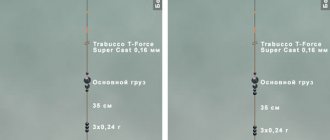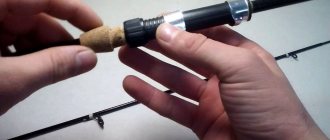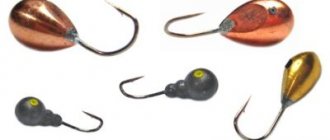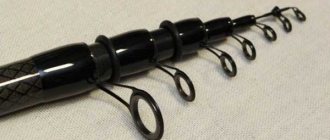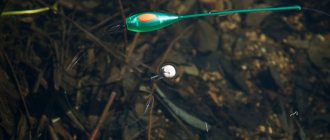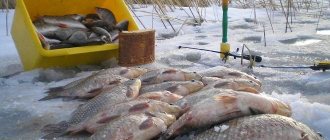Match fishing, choosing a location and determining the bottom topography
Before you start searching for a fishing spot, you should familiarize yourself with the habits of the river inhabitants you are going to hunt. What kind of bottom do they like (shell rock, clay, silt, sand), at what depth, and where should they be looked for (water column, water tables, upper or lower edge, hole, channel), are they suitable for hunting those falling into the water? insects, from tree crowns hanging over the water, etc.
To determine the bottom topography and depth, we use a marker float.
Initially, we need to put special marks on the rod, which are placed at a distance of 50 cm and 1 m from the spool.
Tags
After we cast the tackle, the float along with the weight goes to the bottom, then we make a couple of turns of the reel to pull the float to the weight as much as possible. Now, using a bittrainer or loosening the clutch, we take the fishing line near the reel and pull it along the rod to the previously marked marks until the float appears on the surface. This way we measure the depth at the casting point. Afterwards, we slowly reel in the fishing line so that the float lowers to the weight and slowly use the rod to pull the weight to the shore, determining the bottom topography (hard, soft, whether there are stones or other irregularities). When measuring depth, it is advisable to use braided fishing line, as it is very sensitive. At the end of the braided fishing line, we mount a shock leader made of monk, 0.4-0.5 mm thick and a length equal to the depth of the reservoir, and a weight and a float are attached to it.
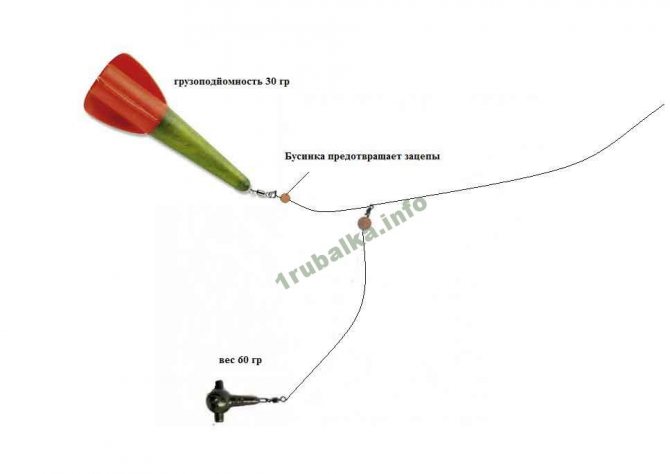
marker-float
We use a leader monofilament shock because it is very difficult to slide through the braided line, the eye of the swivel or the ring of the weight.
It is advisable to find the upper and lower edges, then feed them and fish a little on both in order to understand where the bite is better and, accordingly, match fishing will be more successful.
How to fish with match gear
The advantages of match gear for some fishing conditions are significant. With a matcha you can reach the fishing spots of a reservoir at a distance of 20 - 40 meters, where it is impossible to reach with a fly rod. This increases the likelihood of catching large fish, which are careful and do not come too close to the shore. The noise produced is low, which is important for shallow waters when catching large, cautious fish.
But some features of fishing with a match rod require special skills from the angler:
- long-distance casting of a float is a technically complex operation;
- it is difficult to ensure the accuracy of baiting a place far from the shore;
- Hooking and landing fish is done in a special way.
Let's look at the features of the gear itself and the process of effective fishing.
Rod
In amateur fishing, match rods with a length of 3.9 – 4.2 meters are more often used. Athletes often use 4.5 - 5.1 meter sticks to throw further.
For the form, the main requirement is the presence of the required number of guide rings installed on high legs, which will prevent wet fishing line from sticking.
It is believed that the number of rings should be no less than the length of the rod in pounds. For example, with a length of 14 pounds (4.2 meters), the number of rings, including the tulip, should be 14 - 16 pieces.
The test and structure of match rods is designed for casting equipment weighing up to 25 g. Moreover, sometimes the test category is not indicated on the form at all.
Which fishing rod to choose
For regular fishing, it is not at all necessary to use match rods from world brands. It is enough to use any light carbon fiber rod of the required length with the required number of rings. A regular 4-6 knee telescope is not suitable here due to the lack of a sufficient number of access rings. But recently, so-called match telescopes made of reinforced carbon fiber, with a large number of elbows (and, accordingly, throughput rings), durable and lightweight, have appeared on sale.

Coil
The match reel has a spool with low sides. The wound line should be almost level with the sides so that unnecessary resistance is not created when casting light equipment. The diameter is large, which reduces excessive line twist.
Also, the reel should be light in weight and have a soft, continuously adjustable brake, designed to work with fishing lines with a diameter of 0.08 mm or more.
When choosing, the brake performance must be assessed first.
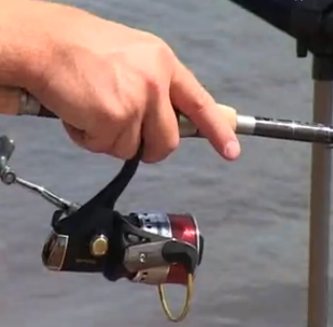
It is preferable to use a high-speed reel with a gear ratio of at least 1:7. This will save time when re-casting gear.
For those who are just mastering the match, a cheaper option may be suitable for a while. If the spool is not suitable, then backing is wound on it to increase the winding diameter (speed) and raise the line to the level of the side.
fishing line
There are also certain requirements for match fishing line. It should be heavier compared to regular monofilament, or it should be coated with a special weighting compound (on the packaging, the match material is marked, for example, with the word “sinking”). It is easier to sink such a line, which increases the comfort of fishing, especially in windy weather.
The use of ordinary fishing lines is possible, but then you should choose one that is as soft and elastic as possible, and has less memory for twisting. It is treated with a detergent composition, then it sinks better.
It is advisable that the fishing line be dark in color; marker marks will be more visible on it.
Line diameter
Thin fishing lines of the order of 0.1 - 0.12 mm significantly increase casting range and reduce windage from water currents, but are afraid of jerky loads when casting gear.
You can combine and use shock leader in match gear. That is, the float and equipment are mounted on a thick fishing line, for example with a diameter of 0.18 mm and a length of at least 8 meters, and the main fishing line is used with a diameter of, for example, 0.12 mm.
With a shock leader, you can manipulate the tackle much more confidently, and the final stage of fishing for large fish on a thick line reduces the risk of breakage.
To reduce the stickiness of the fishing line, during use it is periodically washed with a special degreasing compound. Kitchen detergents will also work.
Float
Depending on the depth of fishing, two types of floats are used - sliding (waggler type) and fixed. The use of a fixed rod is possible at depths of no more than 3 meters maximum, which is 3/4 of the length of the rod. But for comfortable fishing - no more than 2 meters.
The match float is equipped with a built-in weight to provide the necessary aerodynamics. The center of gravity of the float is shifted down. This gives stability in flight and the ability to use the float as the main load when casting the tackle, leaving the load on the line minimal, which means the entire tackle is more sensitive.
The float uses a long and thick antenna. It should be painted in such a way as to create a good contrast with the multi-colored backgrounds of the water (shadow, glare, twilight). More often, the antenna is painted black with bright orange stripes or bright red.
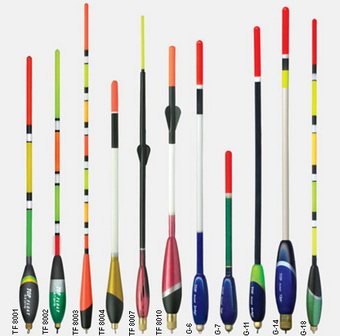
Float attachment and depth adjustment
The fixed float is attached to the fishing line using cambrics pre-attached to the fishing line. The sliding float is attached to a ring that moves freely along the fishing line.
To fix the extreme positions of the sliding float, rubber stoppers (commercially available) are put on the fishing line, which freely pass through the rod rings when casting and move with force along the fishing line.
The position of the upper stopper regulates the depth at the fishing site, the lower one regulates the distance from the float to the equipment when casting.
You can use special float mounts, or design something similar yourself.
Elements of match equipment
In match rigs, a swivel is often used between the main line and the leader. This partially compensates for the twisting of the line from the rotation of the bait during casting or when retrieving in the water. After all, the wiring distances are considerable, the bait twists the line.
The match method of fishing does not impose any special requirements on hooks, weights, and leash material. The choice of these components depends on the fishing conditions, tactics used, fish, bait, weather, etc. For example, when fishing at great depths and active biting, the entire weight is installed closer to the hook in order to quickly deliver the bait to the bottom. In most cases, a simple load is used to reduce entanglements.
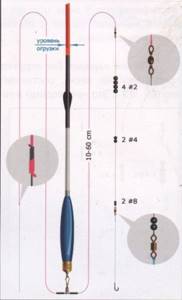
Small hooks
With a fly rod, hooking is done according to the sagging of the float - when the fish takes the bait. In matcha, the equipment is an order of magnitude coarser, and the length of the fishing line to the hooks is longer. The timeliness and impact of cutting is significantly reduced. The fisherman reacts only to the fish carrying the bait to the side and flooding the float. Therefore, during the match, it is more effective to use small hooks that would be swallowed freely by the fish.
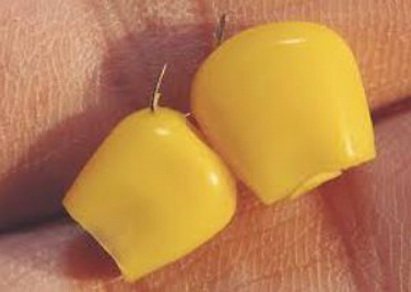
Installing a match rod while fishing
The fishing line must be located underwater, which is not always easy to do. Otherwise, it will quickly be carried away by waves and surface currents. Also, hooking with a line lying on the water will have less effect.
The fishing rod should be installed at an angle so that the tip of the fishing rod is necessarily under water at a depth of about 10 cm. It is better to use two stands for the fishing rod, and the passage ring on the fishing rod should rest against the stand. This will prevent the fish from slipping into the water or stealing the tackle.
Casting technique
The success of fishing with match gear will depend on the accuracy of your casts. Each cast should place the bait on the feeding spot. To ensure accuracy, landmarks are selected on the opposite bank, and a marker mark is made on the fishing line near the reel, long and clearly visible. Instead of a marker, you can use regular ink shading - corrector.
When casting, as a rule, a short flight of gear is made, then the line is reeled in until the mark approaches the reel.
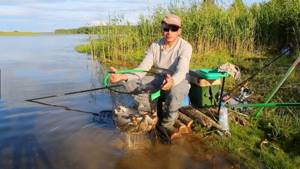
Feeding
The place is baited by precise casting of bait balls using a slingshot or by hand, if distance allows. You can use the following recommendations for slingshot casting.
- The hand that holds the cup with bait should be in the same place before casting, namely, pressed against the lower part of the chest or belt.
- The tension of the rubber is performed by the hand that holds the body of the slingshot. Due to the same distance at which the arm is extended, the same tension in the rubber is achieved.
- The angle of the shot relative to the horizontal will determine the flight range of the bait, so you must try to maintain this angle.
- Actions are performed monotonously, according to the same pattern. The more automatic the handling of the slingshot is, the more accurate the feeding will be.
- The recommended length of rubber on a slingshot is about 25 cm.
- To master slingshot shooting, it is better to use small balls of bait - about the size of a nut. Then there will be less food sent to the wrong place. After mastering the technique, you can move on to shooting with “oranges”.
Sweeping
To choose the strength and style of hooking, you should always take into account the fishing distance and the amount of free line in the water. With short distances and a straight line, the hooking should be more careful.
In the case when there is a lot of fishing line in the water, which, as a rule, is located in an arc, it is better to hook by moving the rod to the side of the leading hand (for a right-handed person - to the right). You need to move the rod as low as possible so that the line moves under the water. Also, simultaneously with raising the rod, you need to select as much line as possible with the reel.
It should be taken into account that the closer to the water the trajectory of the fishing rod is, the less energy is spent on separating the line from the water, and therefore the time of hooking itself decreases.
The braking torque of the reel, for a fishing rod “waiting” for hooking, should not exceed 50% of the breaking force of the fishing line. In case of hooking a large fish, or too much hooking force, the scrolling spool should act as a compensator.
Fishing
Small fish, as a rule, are landed on the shore without lifting the rod, but only by rotating the reel. It is better to fish for fish whose resistance is noticeable with the help of a fishing rod - periodically lifting the rod and dragging the fish (winding the fishing line onto the reel is done when lowering the fishing rod).
Premature rise of the fish to the surface increases the likelihood of a descent due to possible sudden somersaults of the fish. Underwater retrieve is smoother and more uniform at match fishing distances, allowing you to tire out the fish while still on the move and freely take it into the landing net near the shore.
Match tackle makes it possible to cope with the largest trophy, provided there is a sufficient supply of fishing line on the reel. Large fish will get tired faster if the clutch is adjusted to the maximum possible resistance. When fishing, the braking torque of the reel should be set to approximately 0.6 - 0.7 of the breaking force of the fishing line, then the likelihood of it coming off the hook is less and the trophy will sooner please you with its appearance on the shore.
Scheme of regular fishing with a match
Above were the main distinctive points of fishing with a match fishing rod. Before fishing with it, it is advisable to master the simpler gear to use - swing and feeder. When fishing, all the necessary tactics are performed - a place is selected and the depth is measured. Since the edges become available, the hunt goes for them first. The fish are fed according to the classical scheme.
Preparing for match fishing, guidelines
Before starting fishing, we set the fishing depth and range using a marker float. To do this, we throw our tackle into the place where the marker float is located, wait until the weight drops to the bottom, and near the reel, with a special marker, we make a mark 0.5-1 m long. Now we have a guideline by which we will understand threw the tackle accurately or undershot and overshot. After this, we take out the marker float, since it is impossible to leave it in the water as a guide, since, in the end, we will tangle the tackle on it. It is worth remembering that the marker mark needs to be updated every 30-40 casts, as it wears off over time.
In order to determine the direction of casting, we select a landmark (tree, bush, pole) on the opposite bank. So, now the direction of casting is indicated to us by a landmark, and the distance is determined by the mark.
In the process of match fishing, the float may shoot off, and in order not to lose the feeding place, you need to stick a stick or stand under the rod, along the edge of the water, and hook the hook onto it. Next, we move away from the shore, unwinding the line from the reel until a marked section of the line appears, and at this point we stick a stick into the ground, now even if we break the tackle, our fishing range is marked by the distance from the edge of the water to the stuck stick. You can also mark the fishing line that we used to measure the depth, and then, using the 1 and 0.5 m marks on the rod, measure the fishing range. Another fairly simple way is to count the number of revolutions of the reel when pulling out the tackle.
Match fishing for beginners – Fishing selections
(Fishing: match fishing rod - “match”)
author of the article Sergey Ripka
The match fishing rod is the most sophisticated float tackle for long casts. It requires proper setup and ideal selection of all components without exception. Only then will you be able to ensure accurate delivery of the bait, and the rod itself will not create problems during fishing.
Float
Considering the fact that the fishing rod is intended for long casts, you will also need an appropriate float that has its own weight, otherwise the tackle will hardly be able to cast far. The most suitable option is a WAGLER float. This float has an extension shape without a keel with a long antenna.
It has its own load, and is equipped with a passage ring located in the lower part. Such a float is attached to the main fishing line using special fasteners consisting of a carabiner and a hollow tube. The float can have a replaceable weight, which makes it possible to quickly change its weight depending on fishing conditions.
As a rule, on the body of the float there is a value for its weight, as well as the weight of the load required for normal operation of the float.
Floats for match fishing rods are surrounded almost completely, leaving from 1 to 5 centimeters above the surface of the water, no more.
fishing line
You can wind any fishing line onto the reel of a match fishing rod, including a special sinking line that has great elasticity and does not have memory. This is necessary to reduce the influence of wind and waves while fishing. As for the thickness of the fishing line, it is chosen based on factors such as casting distance, the weight of the float and the size of the fish.
Installation of equipment
If you plan to fish at great depths, then the float is movably attached to the main fishing line:
To fix the depth, use special rubber (purchased) stoppers or homemade ones made from scrap materials:
In places where additional elements or a leash with a hook are attached, swivels are installed that do not allow the fishing line (leaders) to twist. If the fishing depth is less than the length of the rod, then the float is attached rigidly in relation to the fishing line, which makes the tackle more sensitive.
Match fishing casting tactics
Circular casting - used when there are no bushes or trees behind us and from the side. The essence of this cast is that we hold the rod over our right shoulder behind us, and without stopping, we cast.
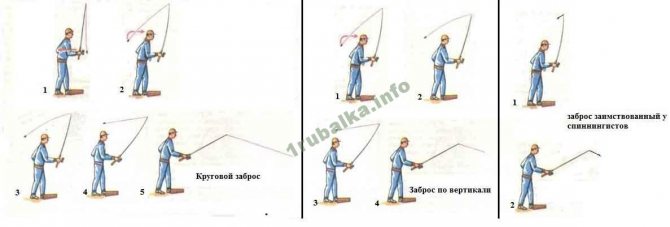
Casting methods
Vertical casting - differs from the first method in that the rod is initially placed behind the back and we cast from this position
In match fishing, a fairly simple but very accurate method of casting has taken root, which is used by spinning rods, and with this method of casting you will not be disturbed by bushes growing on the sides and behind, although in this case the rod should have a very soft tip. So, the starting position is the float is pulled to the tip of the rod. When casting, we lift the rod up, almost vertically, and without putting it behind the head, with a sharp jerk forward, we cast.
After you have cast, lower the tip of the rod into the water, and at the same time, quickly reel in the fishing line with the help of a reel in order to sink it. We submerge the fishing line so that the wind does not affect it and does not blow the tackle away from the baited area. Then you can put the rod on the stand, but only make sure that the tip of the rod is in the water and slowly reel it in to the marker mark.
When casting, it is better to make a throw of 5-10 m, because it is easier to reel in than to pull out the tackle and cast again.
Blind installation of match equipment
The simplest type of installation, it is better for beginners to start with it, as it is easier to learn, the tackle flies better and gets tangled less. What is meant by the concept of blind installation is when the float is firmly fixed to the main fishing line with the help of a special fastening.
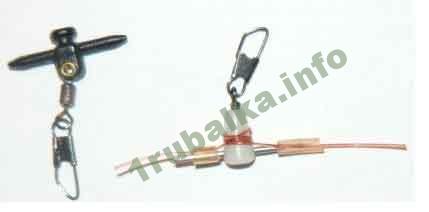
Float mount
You can fish with a blind rig at a depth of 70 cm to 2.5 m, and if the weather is calm, then even 3 m. The advantages of blind mounting a match fishing rod are that the depth is fixed, and when the float rests on the water, the fishing line does not pass through hole of the sliding fastening and is not subject to friction, due to which the tackle often sinks to the bottom for quite a long time, as a result of which it is necessary to make the loading of the float heavier, and when fishing at shallow depths, the fish behaves too carefully and reacts negatively to rough equipment, therefore, the lighter tackle, the less careful the fish and the better the bite.
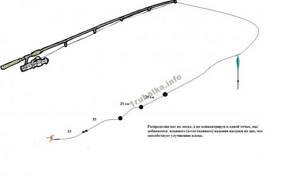
Blind rig for fishing close to the shore
Blind installation of match equipment requires the use of thin monofilaments with a diameter of up to 0.16 mm; a larger diameter is not worth taking, but if anyone has doubts that he will be able to cast such a thin equipment and not break it when casting, then it is better for him to use a shock- leader (line 0.2-0.22 mm thick). In order to properly tie a shock leader, use the article on how to tie fishing knots .
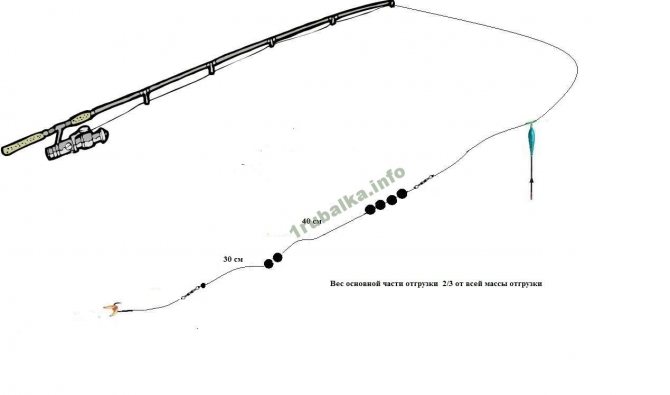
Match-blind-float long cast
Its length will be equal to two lengths of the rod itself plus a margin of half a meter, that is, when we cast, we should have a couple of turns of the shock leader left on the reel, then the entire load falls on it.
Float mount
As a rule, it consists of two cambrics and rigid fasteners (a carabiner and two sticks). First, we pass the fishing line through the cambrics, we fix one end of the stick with the first cambric, and then we make two turns along the axis where the swivel is attached, and fix the second end of the stick with the remaining cambric. There are more advanced fastenings that have a special groove for the fishing line, where we can wrap it around it and lock it. We make turns so that the float itself does not move from its place when casting.
Correct loading of the float
Since this fishing is aimed at peaceful fish, you should definitely use grazing bait. The blind mounting of a match fishing rod is designed for the use of floats weighing up to 12-14 grams. Basically, floats for match fishing have their own weight and we just need to add a few grams so that the float is set to the desired depth. When loading a float, we should not concentrate the weight at one point, using one heavy pellet, we need to collect several weights, from larger to smaller. For example, we put a pellet weighing 0.5-0.4 grams as the main load, two pellets weighing 0.25 grams, and a couple of small pellets as backup pellets (weights weighing 0.08-0.1 grams). The main loads create a mass that will work against the fall. The distance between the main load and the shedding weight is 25-30 cm; the shepherd weights are located near the leash or directly on it. The length of the leash should not exceed the distance between the main loads and the under-grazing. The leash is secured by loop-to-loop assembly or with the help of a swivel.
Match fishing technique
If there is no bite, don’t just stare sluggishly at the float and wait for a miracle; try changing the bait, using thinner baits and a smaller hook. You can also change the equipment and distribute the weights along the fishing line so that the bait sinks to the bottom more slowly and lingers longer in different layers of water. If, on the contrary, you didn’t have time to cast, but small things immediately bite you, then concentrate the weight of the weight at one point so that the bait reaches the bottom faster, you can also try fishing with larger baits.
Due to the fact that match fishing takes place at a fairly large distance from the shore, the weight of the equipment is quite large, and the size of the hook is small, we will see a bite after the fish has swallowed the bait, so you need to hook as soon as you see the slightest movement float For the same reasons, you should always take an extractor when fishing to remove the hook from the fish’s mouth. The hook must be sweeping and strong, which is why we need to clearly adjust the clutch so as not to break the rather thin gear, because the thinner the line, the easier it is to make a long cast, and in this case the fish are more willing to bite.
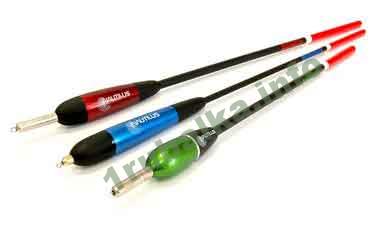
Wagler float
In calm weather, when the water surface is smooth, the float should be loaded so that the tip barely peeks out of the water. In cases where there are weak ripples or are loose, we ship the float so that you can easily see the bite. For more details about shipping and equipment, read the article “ Making the correct installation of match equipment ”
When baiting, it is better to leave the hook tip open, since the fish is not afraid of it, but when hooking, this will give us a slight head start.
Match fishing rod equipment for fishing in currents
Match fishing rod equipment. Fishing with match gear only in standing waters means greatly narrowing the possible areas of its application.
Situations often arise when, on rivers or canals, because of the coastal shallows, fly rods or “plugs” simply do not reach the depth (and the fish), and the bottom tackle turns out to be insufficiently sensitive.
In these conditions, competent use of long-distance casting can be very effective. Why match fishing? After all, it is generally accepted that in the current you need to use a Bolognese rod. However, the most significant advantage of the latter is good control over the float and, accordingly, high quality wiring.
Further, there are continuous disadvantages - if a strong wind blows against the current, or even a weak one, but along, as if from high-quality wiring, only memories remain, and fishing with a Bolognese fishing rod in the rain, which, unlike sunny Italy, is not uncommon here, cannot be done at all out of the question - the fishing line, due to the small number of guides, sticks tightly to the rod, turning fishing into hard labor.
Among other things, a Bolognese rod is much heavier than a match rod, and you have to hold it in your hands throughout the entire fishing trip, while light and rigid models are significantly more expensive than match rods. And one more important point - the Bolognese fishing rod rarely allows you to cast the equipment further than 30-35 m from the shore and at the same time maintain high-quality control over it when retrieving.
As you can see, there are much more minuses than pluses, which tips the scales towards using a match rod for fishing in the current. Although, of course, in conditions that are ideal for fishing with a Bolognese fishing rod and if it is available, you should use it. As always, let's start with the rod.
Fishing on the current in this regard is quite democratic and allows for a wide range of fishing rods, although there are still some restrictions.
The most important of them concerns the length - at least 3.9 m, preferably 4.2-4.5, and even 4.8 m.
I note, however, that the recently appeared match rods with a length of over 5.2 m, although they are designed for fishing in the current, completely exclude any long casting - these are only wire rods.
Match fishing rod equipment
The structure of the rod can also vary within a very wide range; perhaps you just need to abandon very soft and light fishing rods designed for classic line fishing. It’s very good if you have the opportunity to select a rod in terms of power and stiffness, based on the expected size of the fish. The most popular test is from 5 to 20-25 g.
It makes no sense to give specific recommendations on rod models - there are a huge number of them, and if you wish, you can always choose an acceptable option both in price and quality. The main requirement for a reel is a high reeling speed: fishing in the current requires a large number of recasts, and when using a low-speed reel, part of the time on the pond is wasted.
However, you can live with this during regular fishing. The basic requirements are standard for match reels: precise operation of the friction brake under light load conditions; one or two spare spools for thin lines, etc.
The leaders among reels for match fishing are products from Shimano, however, taking into account the relatively low requirements for a reel for long-distance fishing, you can choose a cheaper option. The most commonly used fishing line is with an actual diameter of 0.14-0.16 mm, sometimes a thicker one may be needed - up to 0.18 mm.
It is better if the fishing line is sinking, although this property is not always used, but such fishing lines are softer and more elastic, which always improves long-cast fishing. The diameter of the leader and the size of the hook are selected based on the expected size of the prey.
For roach, white bream and silver bream - a leash of 0.08-0.1 mm and a hook No. 20-16; bream, roach – 0.1-0.12 mm and No. 18-14; and for larger and stronger fish - 0.12-0.15 mm and No. 16-10, respectively. When using compact baits - bloodworms, maggots, pupa, single small grains - the hook is chosen smaller, and for a worm, several grains, etc. – larger.
The most crucial moment is the choice of float; it largely depends on the fishing method used. For fishing in the current, both conventional Wagglers with loading and one attachment point, and Bolognese floats with two to three attachment points can be used.
The carrying capacity of the float varies over a very wide range - from 2-3 to 15-20 g and, of course, is determined by the fishing conditions: the strength of the current, the required casting distance, depth, fish activity, etc. It is better to use a float with a minimum carrying capacity from those that provide the necessary casting range and quality of wiring.
Lure
When choosing the composition of bait, it is necessary to take into account the taste preferences of individual fish species that will be the objects of your match fishing, for example, roach or small crucian carp like bait fractions to be small and turbidity to form in the water.
Bream, on the contrary, is indifferent to turbidity; the main thing for it is that the bait be viscous with many nutritious ingredients. If you catch carp, then it is better that the bait consists of large, aromatic and tasty fractions.
The match bait should not be very loose and break when it hits the water. Therefore, fastening weighting agents are added to it in a proportion of 25%, when fishing in standing waters, to 50%, when fishing in a current; the ratio of the weighting agent to the weight of the bait is also influenced by the depth at the fishing site. The larger it is, the more weighting material is needed so that the bait reaches the bottom faster. Clay has the best viscosity properties; in its absence, or when you need to create loose bait, you can use earth or sand. To hold the bait together, you can use Baby formula or milk powder. The size of the balls is small, no larger than a ping-pong ball, since you have to throw them over quite long distances. The balls must be the same size, so you can take a plastic cup or other container and measure how much bait you need to put in it to get balls of a certain size. For more efficient feeding of fish, the balls can be made of different densities so that they disintegrate at different periods of time.
To deliver bait to the point where match fishing occurs, fishermen use special slingshots, and their size depends on the casting distance. If you fish close to the shore, then you can do without them.
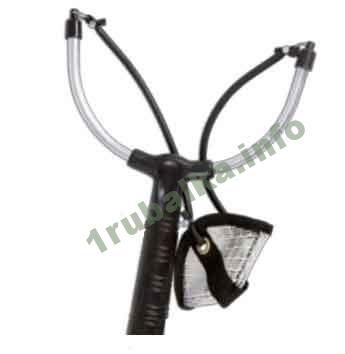
Slingshot
It is better to moisten the bait with water from the reservoir where you are going to fish; it is advisable to take clay or sand there. After you have added water, you need to let the bait sit for about 10 minutes, and then sculpt the balls, it is important to remember that when moistening the bait, you need to be careful and not overdo it with water, the balls should be hard but crumble when broken.
Is it possible to do without a match rod?
The standard length of a match rod, if converted from English feet, is 3.9-4.5 m, which allows you to throw equipment up to 60 meters. You can also find six-meter fishing rods on sale, but they are mostly used by athletes in competitions. The form is three-part, consists of three plugs. The cork handle has a length of up to 60 cm.
A standard fishing rod has from 13 to 16 guide rings, the distance between which decreases as it approaches the tip. Small diameter rings are attached to high legs, which reduces the risk of the line sticking to the blank and gives it a desired trajectory when casting.
If you divide the rods according to test indicators, you get four classes:
- from 2 to 10 g are considered light;
- from 5 to 25 g are universal for matcha;
- from 10 to 30 g are classified as carp;
- from 10 to 40 the heaviest rods.
When choosing a form, you must rely on several factors that influence its characteristics. For example, we wrote about how to choose the length of a fishing rod in the article “Match fishing on the river without any tricks.” Another important circumstance is its structure.
- A soft blank with a slow action is very effective when landing any fish, but you shouldn’t expect long casting with it, and hooking is somewhat difficult.
- A rigid blank with a slow action is designed for large fish. Works with medium-duty wagglers.
- The soft blank with a fast action is the most common due to its versatility.
- A rigid blank with a fast action is specially produced for long-distance drivers. Equipped with heavy floats with sliding equipment.
Along with the above-mentioned fishing rods, 12-foot ones are in good demand, the length of which, translated from the English system of measures, is 360 cm. Their purpose is fishing in small reservoirs where long casting is not required, and in calm water.
In principle, all match rods are designed to work with 20-25 g equipment, which can be assumed if there is no corresponding marking on the form. Naturally, there is no point in purchasing more powerful fishing rods. Moreover, often fishermen do without match rods, replacing them with any others that have guide rings.


